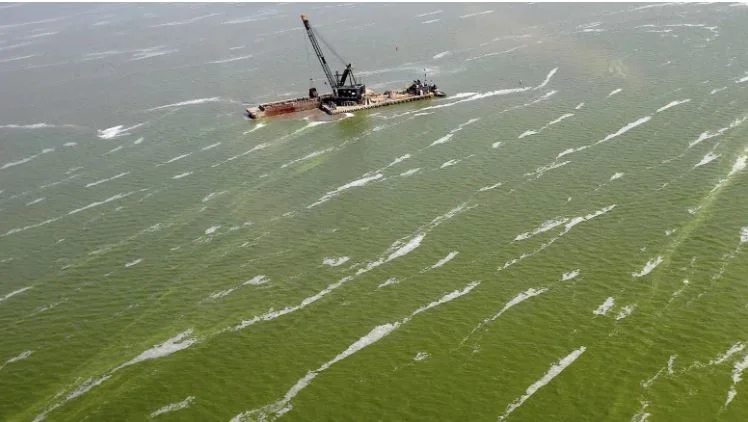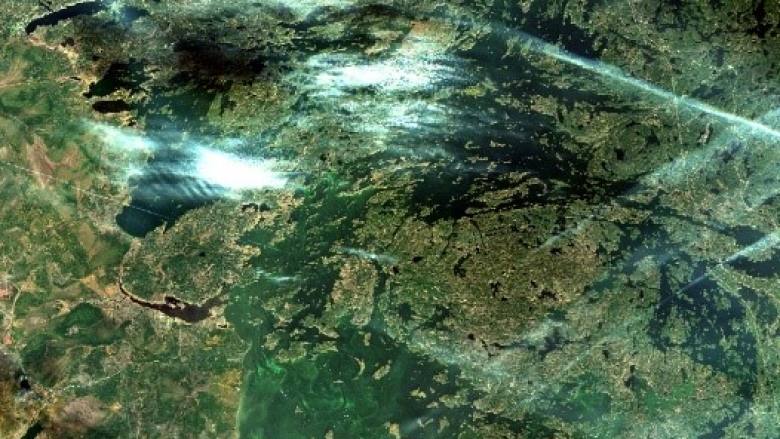Plankton are not just a diabolical mastermind on a Nickelodeon show about a sponge who lives under the sea. Lake Tahoe is filled with them—the good kind. Tahoe native zooplankton are making a comeback in the more than 21-mile long lake, helping it look the clearest it has in 40 years. A comeback because until now, the microorganism's population significantly decreased after it's primary predator, the Mysis shrimp, was on the rise, according to previous Sacramento Bee reporting.
Come on in, the water’s fine: Sask. lake shakes off the algae
In July, 2022, an SHA notice posted on the resort village’s Facebook page warned people to avoid swimming or skiing and to keep children and pets away from the water. The village later levels of toxic blue-green algae were 600 times higher than recommended for public recreation. This year, it’s a different story. “We don’t have any issues in terms of blue-green algae and E. coli,” said Mattick. “So it’s good for swimming or whatever you want to do.”
Water Dance raises awareness in Gananoque
Gananoque welcomed a global event to its waterfront community this past weekend. On Saturday at Confederation Park, at 11 a.m., 10 members of the community, varying in age from 58 to 82, were all decked out in white clothing and danced to numerous soothing songs. The Gananoque River glowed and flowed in the background. The point was to bring awareness to the audience about water, including the Gananoque River, and the importance of its health and impact on communities. The Gananoque River is frequented by algae in the summer months.
Bright orange ocean water being tested by B.C. scientists
Scientists are taking a close look at a bright orange algae bloom found in the ocean off Vancouver Island and the Sunshine Coast. Svetlana Esenkulova, a biologist with Pacific Salmon Foundation, is trying to determine if the phytoplankton bloom is negatively impacting salmon. “Noctiluca blooms can disrupt the overall balance of marine ecosystems as they ‘steal’ food from zooplankton,” she said. Under a microscope, the organisms "look like giant watermelons with pigtails and they wave those pigtails," said Esenkulova, who has a sample of the orange ocean water in her kitchen. When the water is cold, she can see the organisms trying to catch food.
Algae to blame for 'earthy' taste of drinking water, Pointe-Claire says
The city of Pointe-Claire issued a statement to local residents Wednesday, saying the “earthy” taste and unusual odour emitted by their tap water is due to the increased presence of algae in the St. Lawrence River and does not represent a danger to the public’s health. Noting that “a slightly different odour and taste might be noticed in the drinking water coming from the city of Montreal’s Pointe-Claire water production plant,” the municipality explained that such situations occur “during summer and fall and are due to algae in the river.”
Blue-green algae bloom warning for Penhorn Lake
The Halifax Regional Municipality is warning of a blue-green algae bloom at Penhorn Beach in Dartmouth. The city is warning people not to swim in the lake and to keep pets out as well. Lake users are urged to take the following precautions: Avoid water contact. If contact occurs, wash with tap water as soon as possible. Do not swim or wade (or allow your pets to swim or wade) in the water. Avoid consuming water from the lake. Avoid consuming fish from the lake.
'Sleepwalking to disaster': Biology prof on how climate change is wreaking havoc on our lakes
When you head down to a lake in Canada this summer, you might spot more algae covering the surface than usual. This is just one of the scary impacts that our warming planet is having on lakes globally right now, according to a biology professor. It’s part of a pattern that is only going to increase with global warming, John Smol, a professor at Queen’s University, told CTV News Channel, painting a picture of lakes shrinking, others flooding, fish species dying out and algal blooms killing off underwater plants.
Bacteria, sharks, man o' wars: Why Canadians can't find a place to cool off in the sweltering heat
As summer temperatures rise, Canadians may have trouble finding a place to cool off in the sweltering heat for reasons ranging from E.Coli in British Columbia to shark sightings in Nova Scotia. It’s an especially hot summer, with heat warnings by Environment Canada for many cities across the country in July. Temperatures are creeping above 30 degrees Celsius. Some Canadians have even been evacuated from their homes due to wildfires, like the one in Lytton, B.C. this month.
Viruses are not always the bad guy
Every couple of weeks, postdoctoral researcher Yosuke Yamada grabs a bucket and makes the short drive from his lab at Okinawa Institute of Science and Technology to one of the nearby ports on the southerly Japanese island of the same name. He passes Okinawa’s iconic beaches, where snorkelers visit clownfish and coral reefs, and continues to the fishing wharfs. After Yamada scoops a bucketful of water from between the boats, he heads back to his lab to study components of the island’s ecosystem that are so small they must be observed using a microscope: bacteria, viruses, algae, and fungi — the ocean’s microbes.
Scientists to hit the ice for Great Lakes winter research project
A binational team of scientists hits the offshore ice later this month to study the Great Lakes ecosystem in the winter, a first-of-its-kind data collection effort aimed at revealing new insights into one of North America’s most precious natural resources. Dubbed Winter Grab, the research project includes a University of Windsor duo and will see ice drilling, water sampling and the gathering of zooplankton (including algae) at as many as 30 different sites.
What is that smell? Buildup of organic matter causing stench, discolouration at Regina's Wascana Creek
Walking around Regina's Wascana Creek can be a tranquil, meditative experience — until an offensive odour wafts into your nostrils. For several weeks a potent smell has been coming from parts of the creek — which runs out of Wascana Lake — and the water has been discoloured. The smell and colour are being caused by a buildup of organic matter, according to Kurtis Doney, director of water, waste and environment for the City of Regina.
Boissevain-Morton Wants Reduced Water Usage
The Municipality of Boissevain-Morton wants area residents to cut back on the amount of water they use each week. Due to high temperatures and low precipitation, water levels at Boissevain’s water source, the Boissevain Reservoir, are below normal. As a precautionary measure, the Municipality of Boissevain-Morton is asking residents and businesses to consider reducing all water usage. Specifically, they ask that residents reduce water usage for residential landscaping.
Algae in Greater Victoria can clean water, produce biodiesel, says Grade 11 student
Research showed her that plants have impressive water purifying properties, so Lee began searching fresh water bodies around Greater Victoria for an algae that would meet her requirements. At Swan Lake, she found what she was looking for – Azolla filiculoides is an invasive macroalgae known to exist in fresh water bodies around the world and to have absorbing and purifying properties. A study conducted in Iran in 2014 showed the algae could yield up to 58,700 litres of oil per hectare, or about 23,765 litres per acre. The oil can then be used in a biodiesel blend.
Moncton lays groundwork to deal with cyanobacteria in water supply
Moncton plans to spend $6 million this winter to upgrade its water treatment plant, the first phase of a plan to deal with cyanobacteria in the municipal water supply. Cyanobacteria was found in 2017 in the Turtle Creek watershed, the drinking water source for Moncton, Dieppe and Riverview. Cyanobacteria, also known as blue-green algae, can form blooms and produce toxins harmful to humans and animals. The water remains safe to drink and the multimillion dollar upgrades are meant to keep it that way.
Stopping algae blooms may start on farmlands
A handful of Chatham farms might hold the answer to reducing toxic algae blooms in the Great Lakes. These farms are collecting and analyzing their agricultural runoff, in hope of reducing the amount of phosphorus entering the waterways. It's part of a project, started by two organizations in Spring 2016, which aims to come up with a strategy to deal with toxic algae blooms. Out of that idea for the project — between the Ontario Federation of Agriculture and the Great Lakes and St. Lawrence Cities Initiative — came the Thames River Phosphorus Reduction Collaborative.
Moncton could spend $27M on 'worst case' algae fix
Moncton's $77.6-million capital budget sets aside millions to deal with blue-green algae in the municipal water supply. Jack MacDonald, Moncton's general manager of engineering and environmental services, said the city will work with Dalhousie University to study whether a water purification system could be added at the treatment plant to handle the algae.
'Hard on water:' Wildfire smoke can affect nearby water bodies for more than a decade, researchers say
Time to act on algae is now, says organization calling for Lake of the Woods phosphorus reduction
A watershed board focused on protecting Lake of the Woods is calling on Manitoba's provincial government to reduce the amount of phosphorus running into the basin. The organization wants the governments of Manitoba, Ontario and Canada to commit to an 18.4 per cent reduction in phosphorus loads to improve the health of the water body.



















